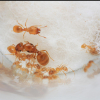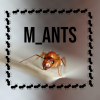- Formiculture.com
- Forums
- Gallery
- Members
- Member Map
- Chat

NickAnter's Temnothorax spp. Journal (chandleri worker!)
Started By
NickAnter
, Aug 24 2019 8:43 AM
113 replies to this topic
#21
 Offline
-
Posted September 27 2019 - 11:33 AM
Offline
-
Posted September 27 2019 - 11:33 AM
Picturesssss
- TennesseeAnts likes this
Spoiler
#22
 Offline
-
Posted September 27 2019 - 3:01 PM
Offline
-
Posted September 27 2019 - 3:01 PM
I will do pictures later. Right now my head hurts, and I need to clean my guinea pig's cage.
Hi there! I went on a 6 month or so hiatus, in part due, and in part cause of the death of my colonies.
However, I went back to the Sierras, and restarted my collection, which is now as follows:
Aphaenogaster uinta, Camponotus vicinus, Camponotus modoc, Formica cf. aserva, Formica cf. micropthalma, Formica cf. manni, Formica subpolita, Formica cf. subaenescens, Lasius americanus, Manica invidia, Pogonomyrmex salinus, Pogonomyrmex sp. 1, Solenopsis validiuscula, & Solenopsis sp. 3 (new Sierra variant).
#23
 Offline
-
Posted September 28 2019 - 9:12 AM
Offline
-
Posted September 28 2019 - 9:12 AM
Here are some pictures: 



Hi there! I went on a 6 month or so hiatus, in part due, and in part cause of the death of my colonies.
However, I went back to the Sierras, and restarted my collection, which is now as follows:
Aphaenogaster uinta, Camponotus vicinus, Camponotus modoc, Formica cf. aserva, Formica cf. micropthalma, Formica cf. manni, Formica subpolita, Formica cf. subaenescens, Lasius americanus, Manica invidia, Pogonomyrmex salinus, Pogonomyrmex sp. 1, Solenopsis validiuscula, & Solenopsis sp. 3 (new Sierra variant).
#24
 Offline
-
Posted October 4 2019 - 3:06 PM
Offline
-
Posted October 4 2019 - 3:06 PM
Here is a good picture. As you can see, they have a bit of brood: 
I am going to wait until all of their brood ecloses to put them in hibernation, unless they don't grow any more.

I am going to wait until all of their brood ecloses to put them in hibernation, unless they don't grow any more.
Hi there! I went on a 6 month or so hiatus, in part due, and in part cause of the death of my colonies.
However, I went back to the Sierras, and restarted my collection, which is now as follows:
Aphaenogaster uinta, Camponotus vicinus, Camponotus modoc, Formica cf. aserva, Formica cf. micropthalma, Formica cf. manni, Formica subpolita, Formica cf. subaenescens, Lasius americanus, Manica invidia, Pogonomyrmex salinus, Pogonomyrmex sp. 1, Solenopsis validiuscula, & Solenopsis sp. 3 (new Sierra variant).
#25
 Offline
-
Posted October 14 2019 - 6:26 PM
Offline
-
Posted October 14 2019 - 6:26 PM
Well, somehow, the cotton fell out, so a worker was lost. They have since gained another worker, and it is of the darker color. They have two more pupae. And about 8 more larvae. Once everything is ecloses, I shall put them in hibernation. Doing well overall.
Hi there! I went on a 6 month or so hiatus, in part due, and in part cause of the death of my colonies.
However, I went back to the Sierras, and restarted my collection, which is now as follows:
Aphaenogaster uinta, Camponotus vicinus, Camponotus modoc, Formica cf. aserva, Formica cf. micropthalma, Formica cf. manni, Formica subpolita, Formica cf. subaenescens, Lasius americanus, Manica invidia, Pogonomyrmex salinus, Pogonomyrmex sp. 1, Solenopsis validiuscula, & Solenopsis sp. 3 (new Sierra variant).
#26
 Offline
-
Posted October 17 2019 - 4:59 PM
Offline
-
Posted October 17 2019 - 4:59 PM
They have a fourth worker. It is a bit bigger, and is of the orange version. This means that they probably were two species, so a new scientific discovery! Once a worker of both varieties dies, I will put them under a microscope to be sure. They still have quite a lot of larvae, and one pupa. Probably my favorite ants, they are so cool looking. Here is a pic of the new worker hiding under the queen:


Hi there! I went on a 6 month or so hiatus, in part due, and in part cause of the death of my colonies.
However, I went back to the Sierras, and restarted my collection, which is now as follows:
Aphaenogaster uinta, Camponotus vicinus, Camponotus modoc, Formica cf. aserva, Formica cf. micropthalma, Formica cf. manni, Formica subpolita, Formica cf. subaenescens, Lasius americanus, Manica invidia, Pogonomyrmex salinus, Pogonomyrmex sp. 1, Solenopsis validiuscula, & Solenopsis sp. 3 (new Sierra variant).
#27
 Offline
-
Posted October 21 2019 - 6:00 AM
Offline
-
Posted October 21 2019 - 6:00 AM
Worker number five has eclosed. It too is of the lighter morph. Oh yeah, and two days ago, I fed them a drywood termite soldier. They loved it.
Edited by NickAnter, October 21 2019 - 6:13 AM.
- TennesseeAnts likes this
Hi there! I went on a 6 month or so hiatus, in part due, and in part cause of the death of my colonies.
However, I went back to the Sierras, and restarted my collection, which is now as follows:
Aphaenogaster uinta, Camponotus vicinus, Camponotus modoc, Formica cf. aserva, Formica cf. micropthalma, Formica cf. manni, Formica subpolita, Formica cf. subaenescens, Lasius americanus, Manica invidia, Pogonomyrmex salinus, Pogonomyrmex sp. 1, Solenopsis validiuscula, & Solenopsis sp. 3 (new Sierra variant).
#28
 Offline
-
Posted October 26 2019 - 7:21 AM
Offline
-
Posted October 26 2019 - 7:21 AM
Dang it. When feedimg them honey I accidentaly squished a worker in the cotton when I tried to close it, as it was on the underside of the cotton. Back down to 4 workers. At least they have 3 more pupae on the way.
- TennesseeAnts likes this
Hi there! I went on a 6 month or so hiatus, in part due, and in part cause of the death of my colonies.
However, I went back to the Sierras, and restarted my collection, which is now as follows:
Aphaenogaster uinta, Camponotus vicinus, Camponotus modoc, Formica cf. aserva, Formica cf. micropthalma, Formica cf. manni, Formica subpolita, Formica cf. subaenescens, Lasius americanus, Manica invidia, Pogonomyrmex salinus, Pogonomyrmex sp. 1, Solenopsis validiuscula, & Solenopsis sp. 3 (new Sierra variant).
#29
 Offline
-
Posted December 4 2019 - 6:50 PM
Offline
-
Posted December 4 2019 - 6:50 PM
The cotton was found unlugged. I have no idea how, I never opened it for days, and checked yesterday, and they were fine. They are all gone, and had 12 brood and 8 workers. And they were my favorite colony. I have set up some test tube setups in my room to hopefully coax them into, wherever they are. ![]()
![]() I will probably find more next summer though, they are super common in a place I go in the Eastern Sierras.
I will probably find more next summer though, they are super common in a place I go in the Eastern Sierras. ![]()
Hi there! I went on a 6 month or so hiatus, in part due, and in part cause of the death of my colonies.
However, I went back to the Sierras, and restarted my collection, which is now as follows:
Aphaenogaster uinta, Camponotus vicinus, Camponotus modoc, Formica cf. aserva, Formica cf. micropthalma, Formica cf. manni, Formica subpolita, Formica cf. subaenescens, Lasius americanus, Manica invidia, Pogonomyrmex salinus, Pogonomyrmex sp. 1, Solenopsis validiuscula, & Solenopsis sp. 3 (new Sierra variant).
#30
 Offline
-
Posted December 5 2019 - 7:25 AM
Offline
-
Posted December 5 2019 - 7:25 AM
Found the queen, a pupa, two larvae, and 3 workers inside a carboard box, in the walls of it, so I had to peel it apart. All in all, 3 is better than none.
- Antennal_Scrobe likes this
Hi there! I went on a 6 month or so hiatus, in part due, and in part cause of the death of my colonies.
However, I went back to the Sierras, and restarted my collection, which is now as follows:
Aphaenogaster uinta, Camponotus vicinus, Camponotus modoc, Formica cf. aserva, Formica cf. micropthalma, Formica cf. manni, Formica subpolita, Formica cf. subaenescens, Lasius americanus, Manica invidia, Pogonomyrmex salinus, Pogonomyrmex sp. 1, Solenopsis validiuscula, & Solenopsis sp. 3 (new Sierra variant).
#31
 Offline
-
Posted December 5 2019 - 9:56 AM
Offline
-
Posted December 5 2019 - 9:56 AM
Same thing happened to me in August. There was a small hole in a nest I made my huge Temnothorax curvispinosus colony. They had 3 queens and upwards of 200 workers. They moved into a hollow stick I had sitting on my desk. It was FUN getting them out.
My Main Journal | My Neivamyrmex Journal | My Ant Adoption | My YouTube
Join the TennesseeAnts Discord Server! https://discord.gg/JbKwPgs
#32
 Offline
-
Posted December 5 2019 - 3:05 PM
Offline
-
Posted December 5 2019 - 3:05 PM
Well you probably ended up with more than 1/4 of the colony. But I can't even imagine trying to get them out of a stick.
Hi there! I went on a 6 month or so hiatus, in part due, and in part cause of the death of my colonies.
However, I went back to the Sierras, and restarted my collection, which is now as follows:
Aphaenogaster uinta, Camponotus vicinus, Camponotus modoc, Formica cf. aserva, Formica cf. micropthalma, Formica cf. manni, Formica subpolita, Formica cf. subaenescens, Lasius americanus, Manica invidia, Pogonomyrmex salinus, Pogonomyrmex sp. 1, Solenopsis validiuscula, & Solenopsis sp. 3 (new Sierra variant).
#33
 Offline
-
Posted December 5 2019 - 3:29 PM
Offline
-
Posted December 5 2019 - 3:29 PM
It was painful, that's for sure. I got maybe 125 workers back, but got lucky and got all 3 queens.
My Main Journal | My Neivamyrmex Journal | My Ant Adoption | My YouTube
Join the TennesseeAnts Discord Server! https://discord.gg/JbKwPgs
#34
 Offline
-
Posted January 22 2020 - 8:01 PM
Offline
-
Posted January 22 2020 - 8:01 PM
Okay, so here is the current situation, and past events. They lost the third worker. They then gained it back, with then no brood. Then, two workers decided to drown themselves in honey. Then, they were able to get another worker a week or so ago. They also now have a sizable pile of eggs and larva, so, I have hope for them yet. And, they seemed to have no problem without hibernation, which I find very interesting, as heir home area is covered in snow right now. Has anyone else had this experience with Temnothorax?
Hi there! I went on a 6 month or so hiatus, in part due, and in part cause of the death of my colonies.
However, I went back to the Sierras, and restarted my collection, which is now as follows:
Aphaenogaster uinta, Camponotus vicinus, Camponotus modoc, Formica cf. aserva, Formica cf. micropthalma, Formica cf. manni, Formica subpolita, Formica cf. subaenescens, Lasius americanus, Manica invidia, Pogonomyrmex salinus, Pogonomyrmex sp. 1, Solenopsis validiuscula, & Solenopsis sp. 3 (new Sierra variant).
#36
 Offline
-
Posted January 23 2020 - 2:14 PM
Offline
-
Posted January 23 2020 - 2:14 PM
#37
 Offline
-
Posted January 23 2020 - 4:07 PM
Offline
-
Posted January 23 2020 - 4:07 PM
I sure hope so. I still have no idea how that happened. It was in there tightly.
Hi there! I went on a 6 month or so hiatus, in part due, and in part cause of the death of my colonies.
However, I went back to the Sierras, and restarted my collection, which is now as follows:
Aphaenogaster uinta, Camponotus vicinus, Camponotus modoc, Formica cf. aserva, Formica cf. micropthalma, Formica cf. manni, Formica subpolita, Formica cf. subaenescens, Lasius americanus, Manica invidia, Pogonomyrmex salinus, Pogonomyrmex sp. 1, Solenopsis validiuscula, & Solenopsis sp. 3 (new Sierra variant).
#38
 Offline
-
Posted July 16 2020 - 5:09 PM
Offline
-
Posted July 16 2020 - 5:09 PM
The queen died. The workers slowly died off, and the lone queen refused all foods. I will hopefully find more of these in the Sierras when I go on August 9th. This time, I'm going to find as many as I can.
Hi there! I went on a 6 month or so hiatus, in part due, and in part cause of the death of my colonies.
However, I went back to the Sierras, and restarted my collection, which is now as follows:
Aphaenogaster uinta, Camponotus vicinus, Camponotus modoc, Formica cf. aserva, Formica cf. micropthalma, Formica cf. manni, Formica subpolita, Formica cf. subaenescens, Lasius americanus, Manica invidia, Pogonomyrmex salinus, Pogonomyrmex sp. 1, Solenopsis validiuscula, & Solenopsis sp. 3 (new Sierra variant).
#39
 Offline
-
Posted July 16 2020 - 5:26 PM
Offline
-
Posted July 16 2020 - 5:26 PM
![]()
Veromessor pergandei
Veromessor andrei
Crematogaster sp.
Pogonomyrmex cf cali and rugosus
Various Pheidole
C. yogi
#40
 Offline
-
Posted July 21 2020 - 11:20 AM
Offline
-
Posted July 21 2020 - 11:20 AM
In terms of the ID I'm almost 98% sure this is nevadensis, based on the propodeal spines, and the fact that the antwiki page was updated, to show a queen which looked exactly like mine.
And. Another highly interesting thing is that these are known for plesobiosis. Which could possibly explain the two similar, yet different things.
Edited by NickAnter, July 21 2020 - 11:24 AM.
Hi there! I went on a 6 month or so hiatus, in part due, and in part cause of the death of my colonies.
However, I went back to the Sierras, and restarted my collection, which is now as follows:
Aphaenogaster uinta, Camponotus vicinus, Camponotus modoc, Formica cf. aserva, Formica cf. micropthalma, Formica cf. manni, Formica subpolita, Formica cf. subaenescens, Lasius americanus, Manica invidia, Pogonomyrmex salinus, Pogonomyrmex sp. 1, Solenopsis validiuscula, & Solenopsis sp. 3 (new Sierra variant).
1 user(s) are reading this topic
0 members, 1 guests, 0 anonymous users

















